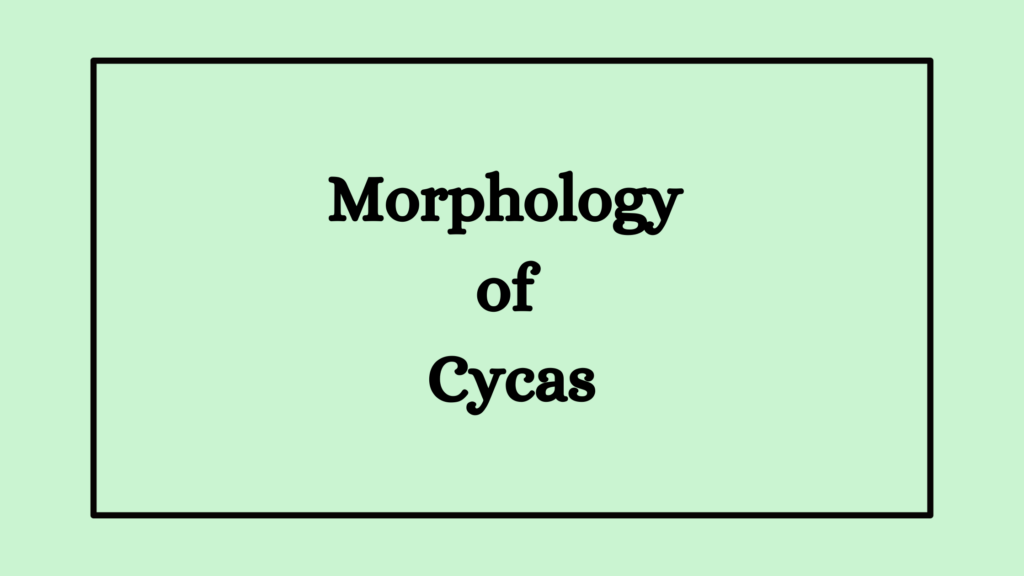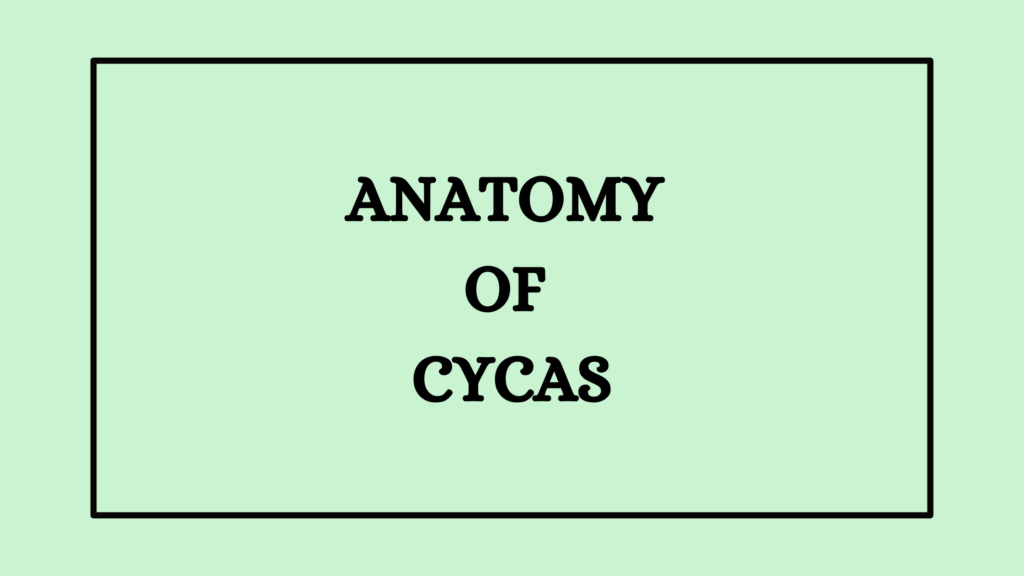Cycas plants reproduce by vegetative and sexual methods.
Vegetative Reproduction in Cycas
Vegetative reproduction in Cycas is by producing tuber-like structures from the base of its stem. Eg. In areas where the Cycas revoluta lacks male plants, female plants do not produce seeds. Instead, they produce tubers to reproduce.
Sexual Reproduction in Cycas
Sexual reproduction in Cycas is through the production of microspores and megaspores produced on male and female plants respectively. Cycas plant is dioecious and produces male and female plants. The male plant produces male cones that bear the microspores in their microsporophylls. The female plants produce megasporophyll which produces the megaspores.
Cycas Male Cone
Cycas male cones are produced on the apex of male plants. It has a central woody axis and a short stalk. They are compact and oval in shape. It is usually 30-60 cm long and in Cycas circinalis, it can grow up to 85 cm.
- The male cones produce microsporophylls from its axis.
- Each cone will have numerous microsporophylls that are spirally arranged on the central axis.
- They are soft when young and turn woody when matured.
- At the base, microsporophylls are smaller and the central part has a higher number of microsporophylls.
- The microsporophylls at the base and tips are sterile.
Microsporophyll
Microsporophylls arise as an outgrowth from the axis but attain a wedge shape on maturity.
- They are 3-3.5 cm long.
- The base of microsporophyll is stout and fleshy but is tough.
- The sporophylls in the middle are triangular and expanded.
- These sporophylls in the middle are fertile and bear microsporangia that produce microspores.
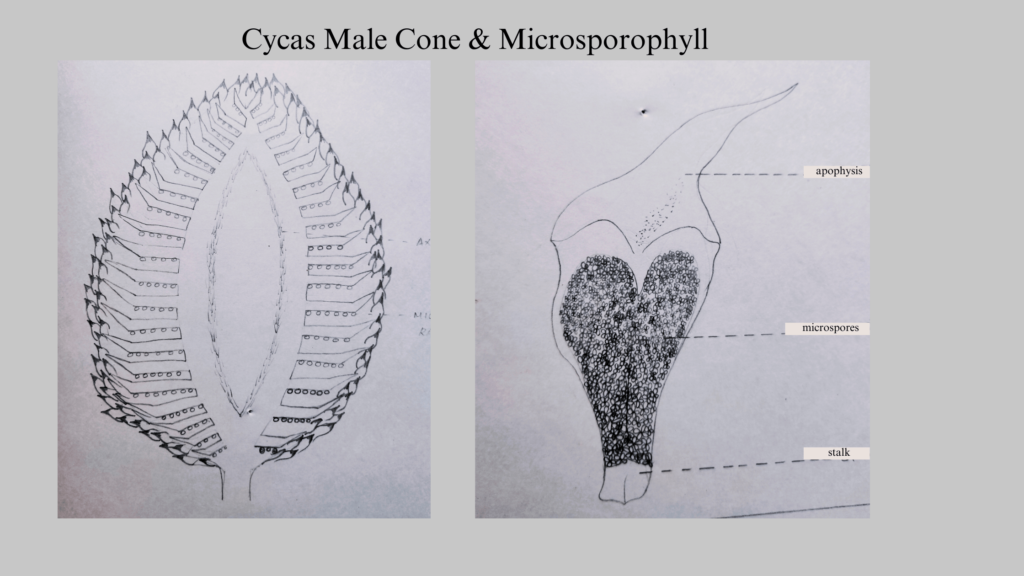
Microsporangia
Microsporangia are sacs or chambers inside the microsporophyll that produce microspores, the male gametes. The microsporangia contain spore mother cells which produce microspores by undergoing meiosis.
- Each microsporophyll contains 720-1059 microsporangia.
- They are grouped into two zones of sori on the lower side.
- Each sori will have 2-6 sporangia.
- Each sporangium will have multiple wall layers and a central sporogenous tissue.
- The cells in sporogenous tissue are called spore mother cells.
- Meiosis of spore mother cells produces microspores.
Microspore Dispersal
The hygroscopic movement of the microsporophyll wall cells releases the microspores.
Each sporangium has thick walls that have a median abaxial line. On the abaxial line, the cells are unthickened. These unthickened cells mark the line of dehiscence.
During the dry season, the unthickened wall cells lose water and shrink. This shrinking pulls the walls in. This causes the sporangia to break open and microspores are released. The wind carries these microspores to various places.
Cycas Female Cones
Cycas plants do not produce a well-defined cone as they lack a central axis. The megasporophylls of the Cycas plant are loosely arranged. They originate from the scale of leaves and foliage. They are arranged spirally, they appear as a rosette similar to the vegetative leaves.
Megasporophyll
The megasporophyll appears larger than the microsporophyll. Each megasporophyll has a stalk and a broad, expanded, leafy portion. The leafy portion is sterile with lobing or serrations. They have pinnate appendages as well.
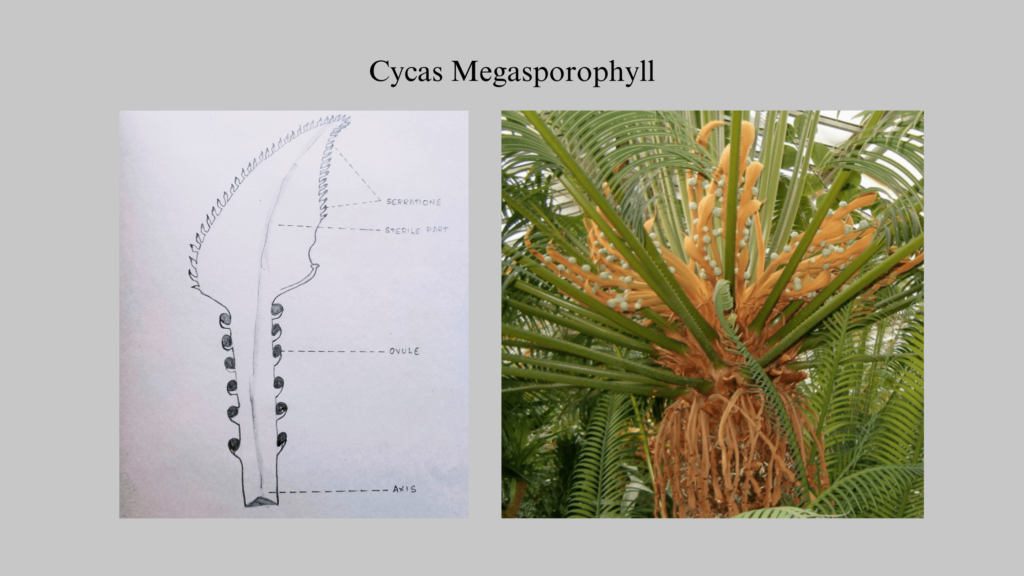
Ovules arise on stalks just below the expanded portion. There may be 2-10 ovules on each megasporophyll, appearing on their lateral sides.
Ovules
Ovules of Cycas are large and orthotropous. They have a stalk attaching them to the megasporophyll. They appear green when young and become orange-red or brown on maturity. When young, these ovules will have woolly hair but they lose these hairs on maturity and become smooth surfaced.
- The main body of the ovules is made of parenchymatous nucellus.
- An integument covers the nucellus.
- The integument has an outer sarcotesta, a middle stoney mesa costa and an inner sclerotesta.
- The outer layer of the integument contains cells with tannins and mucilage canals.
- The integument forms the seed coat after fertilization.
- The apical tip of the ovule forms the pollen chamber.
- The nucellus becomes the endosperm for the embryo.
- The archegonial chamber develops under the pollen chamber.
Megaspores
The megaspore mother cell undergoes meiotic division without cell wall formation, forming a single cell with four haploid nuclei.
- A vacuole in the centre pushes the nuclei towards the periphery.
- A cell wall is produced later to form the female gametophyte.
- One of these cells forms the archegonia and divides to form a neck and central cell each.
- The central cell later develops into the egg.
- Cycas egg is the largest in the Plant Kingdom.
Pollination and Fertilization
The dispersed microspores fall on the ovule and start germinating to form the male gametophyte. At this time, the gametophyte will have a prothallial cell and a distal tube cell. And a generative cell.
The pollen tube grows towards the archegonial chamber of the ovule and transfers the sperm cells. The transfer of sperm cells into the female gamete is called siphonogamy. This process happens around 4 months after pollen tube formation.
The megaspore is produced at the chalazal end of the ovule. The other three megaspores develop into nutritive tissue for the embryo.
Once the pollen tube comes in contact with the archegonial chamber, the contents in the pollen tube are discharged and eventually fertilization occurs. The resultant embryo is called a seed which undergoes a short resting period. Later, it will germinate to form a new Cycas plant.
Post Fertilization Changes & Embryo Development in Cycas
After fertilization the newly formed diploid zygote enlarges and a small vacuole is formed inside. Further changes are listed below.
Free Nuclear Division
The diploid nucleus undergoes free nuclear division.
- In most species of cycas, around 128-256 free nuclei are formed.
- This proembryo enlarges and distributes nuclei in the cytoplasm.
- Cytoplasm and nuclei are disorganized at the centre and the vacuole occupies this space.
- Cytoplasm and nuclei are pushed to the periphery.
- The basal part gets more nuclei at this stage.
- Free nuclear division continues and more nuclei are formed at the base than in the upper area.
Cell Wall Formation
- Wall formation occurs in a basipetal manner, ie, the cell wall is formed from the basal portion towards the upper region.
- The cell wall at the basal area forms the proembryo.
- Gradually, the proembryo is divided into upper haustorial, basal embryonal, and middle suspensor regions.
- The haustorial region gets nutrition from the female gametophyte.
- The suspensor elongates and becomes coiled to push the embryonal area deep into the gametophyte.
- Even if there is more than one embryo, only one embryo matures.
Embryo Development
The embryo development in Cycas is slow. It can take more than a year to complete. The embryonal area continues to grow and produce a dicot embryo.
- The cotyledons are formed on lateral sides and apical growth is arrested at this stage.
- The outer fleshy layer of the seed remains fleshy and changes its green colour into red or orange.
- This forms the testa which tastes sweet and has a pleasant smell to attract birds and animals to help with seed dispersal.
- The middle stony layer is light yellow and becomes hard to form the inner layer of testa.
- The inner fleshy layer is practically absorbed by the developing female gametophyte.
- Nucellus is absorbed and used up to nourish the embryo.
- The endosperm remains fleshy and surrounds the embryo, which occupies the centre of the seed.
- A mature embryo of Cycas is straight and attached to a low coil suspensor.
- The hypocotyl portion of the embryo develops the radicle and the central portion gives rise to plumule.
- The radicle is covered by coleorhiza- a protective covering formed from suspensor cells.
- The embryo has 2-3 cotyledons that enlarge to cover the stem tip.
- This creates a small straight embryo.
The embryo development takes place while the Cycas ovule is still attached to the plant. However, when the embryo development is complete, the seed will be dropped.
Life Cycle of Cycas
Cycas plant is an independent diploid sporophyte. It has a well-developed root and shoot system. The plant is dioecious with male and female cones produced on separate plants. Cycas show alternation of generation between diploid and haploid stages.
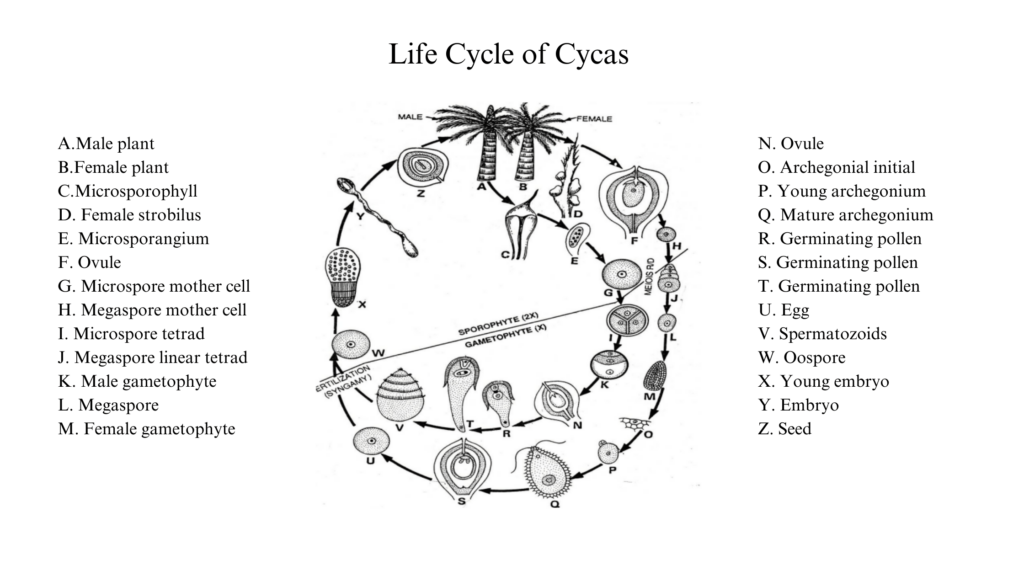
The male cone produces microsporophylls that produce microsporangia. Microsporangia bears microspore mother cells. These diploid microspore mother cells undergo meiotic division to produce 4 haploid microspores each.
On the other hand, the female plant produces megasporophylls that bear ovules. The ovules produce diploid megaspore mother cells. These megaspore mother cells divide meiotically to produce 4 haploid megaspores each. Of these 4 megaspores, only one megaspore survives and develops the female gametophyte.
The formation of the haploid microspores and megaspores marks the end of sporophytic generation. Moreover, both male and female spores develop a short gametophyte, marking the first step of gametophytic generation.
Male and female gametophytes form the sperm and egg respectively. They fuse to form the diploid zygote, while the megaspore is still attached to the mother plant. The microspore is transferred to the ovule germinate to form a pollen tube. When the pollen tube is in contact with the archegonium, it releases the sperm cells. Only one of the sperm cells will fertilize the egg.
The diploid zygote develops into an embryo and grows to form the next sporophytic generation of Cycas. Thus, Cycas shows an alternation of generation between an independent sporophytic generation and a semi-independent gametophytic generation.
References
- Abraham P C. Bryophytes, Pteridophytes, Gymnosperms & Paleobotany. 2000. St. Mary’s Books & Publications.

